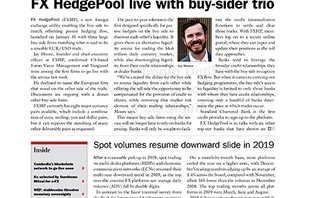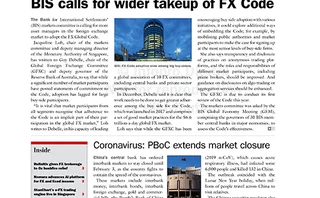
Solvency II highlights need for currency risk management

European financial regulation does not move fast. Three years after the European Commission passed Directive 2009/138/EC, adding Solvency II to its regulatory framework, policy-makers continue to assess its potential impact on the European (re)insurance sector. Although the new rules and protracted consultation are primarily concerned with capital adequacy, regulators have taken a particular interest in how foreign exchange movements can impact firms' asset liability management (ALM).
Indeed, the European Insurance and Occupational Pensions Authority's (Eiopa) most recent quantitative impact study, the fifth of a protracted consultation period published last October (QISV), required insurers to disclose how a 25% +/- move in their reporting currency would impact their
balance sheets.
"For the first time, Solvency II imposes a specific capital charge on currency mismatches between the assets and liabilities of insurance companies.While sudden shocks in the base currencymight net off across the balance sheet to some degree, insurers nowhave to look directly at those mismatches, figure out their potential losses and hold capital against those losses," explains JamesWood-Collins, chief executive at Record Currency Management (CM) in London, which currently manages £16.4 billion (US$25.4 billion) in client currency exposures.
Eiopa also noted in QIS5 that effective currency risk management can reduce the amount of capital insurers will be required to hold, and imposed a set of conditions and reporting criteria firms must meet to qualify for relief. For example, firms must operate a dedicated, documented hedging
programme and report regularly on market, liquidity and counterparty risks.
Counterparties must be rated at least triple B, with further relief available for
collateralised exposures.
"An insurer must be able to demonstrate to regulators that it has a well-established, documented programme in place to qualify for full
capital relief for one year. This includes providing thorough analysis of
trading costs and capital charges related to counterparty exposure," says Wood-Collins.
While this might sound an attractive opportunity for currency managers to extend their FX overlay customer base beyond the pension fund realm, insurance consultants argue that uptake could prove limited. In the UK for example, the Financial Services Authority (FSA) currently monitors
insurers' ALMpractices, including their currency mismatches, while foreign
regulators typically require insurers to hold currency reserves in the foreign jurisdiction to cover foreign liabilities.
David Osborne, director with specialist investment consultant P-Solve Meridian in London, says UK rules effectively incentivise insurers to reduce mismatches. "The FSA has been looking at the issues around capital adequacy for the insurance sector for the past eight years, and has aligned its own capital-setting regime with forthcoming European regulation. During this time, companies have done their own internal capital and risk management reviews, which lead some to upgrade their official policies
for dealing with FX exposures. Given the similarity between the existing regime and Solvency II requirements, we don't expect a big overall impact in the UK," he says.
Moreover, the inherent uncertainty around general insurers' overall liability
exposure means they find little added value in bespoke hedging strategies, Osborne adds. He predicts insurers are likely to continue with the passive, FX forwards-based approach. "The kinds of risks assumed by general insurers by definition create uncertain liabilities, such that the strategic objective of hedging with greater accuracy may be unachievable for many
insurers. I expect most companies will continue with the forward roll strategy.
This generally used solution matches the degree of accuracy with which you can estimate the exposure," he says.
Tangible benefits
Notwithstanding uncertainty on liability exposure, managers argue that an external currency manager can bring tangible risk management benefits for insurance clients on a range of issues. Indeed, in its 2010 review of the ALM practices of UK investment companies, the FSA found most firms didn't have formalised currency risk management processes, and flagged the area as needing improved governance and operations infrastructure. "Very few firms
provide analysis on the foreign exchange sensitivity to net investment in foreign operations and currency revenue flows," the agency said.
At the compliance level, an agreement with an external provider is proof that a firm has an established, documented risk management procedure in place. "An external mandate to hedge foreign currency risk provides documentary evidence of an insurance company's commitment to keep
the hedging programme operational," says Record CM's Wood-Collins.
Moreover, the substantial pricing power, counterparty management and
operational expertise of large currency managers can drive substantial economic gains for their hedging clients. "Our clients stand to benefit from the volume and relationships we have with the banks, which we have developed over 30 years in the FX market.Whether we are trading on
platforms or voice, we have a number of ways to achieve fine pricing," says
Wood-Collins. Record CM, for instance, typically achieves a pricing inside of the WM/Reuters 4pm fixing for both spot and forward instruments, according to its marketing material.
Beyond traditional forward roll strategies, however, managers say dynamic hedging programmes using FX options and other derivatives can allow clients to benefit from market upside when the currency movement is in their favour. "There is increasing awareness among insurance companies
that static hedging programmes can lead to suboptimal risk management outcomes. These firms are open to looking at a more dynamic approach," says Arnaud Gerard, senior vice-president at Pareto Partners in London, which manages US$50.5 billion in currency overlay and absolute return strategies.
Gerard argues that a dynamic currencyhedging programme run by an external manager can improve the predictability of hedging outcomes and simplify the overall risk management decision-making process. "Well-defined agreement guidelines with an external provider can give more
certainty around maximum and minimum hedge ranges, neutral positioning and the risk budget associated with the hedging programme. Clients can know the capital and cashflow requirement of the proposed hedging programme in advance and either allocate or refuse," he says.
Meanwhile, recent litigation in the US brought by investors over the fiduciary
performance of their currency hedge providers has contributed to an environment of increased scepticism towards banks and custodians. Managers are hopeful of poaching disaffected clients from these providers. "Traditional players are likely to view insurance companies' currency
hedging requirements as captive business and price their hedges as wide as they can get away with. Moreover, the counterparty risk for the insurer's FX forwards exposure could sit on one bank's balance sheet until maturity, with serious implications for the clients' counterparty risk profile," a London-based manager says.
Unhelpfully, the QISV report seemingly rules out the use of the very dynamic hedging techniques recommended by currency managers, noting that ‘dynamic hedging should not be treated as a risk mitigation technique' for the purpose of capital relief. "While it's not entirely clear what the regulators mean in their use of the termdynamic hedging, it's our sense that they are trying to exclude firms who base the decision to hedge currency exposure on discretionary judgements or market views," Wood-Collins says.
Without further consultation, themeaning of the term‘dynamic hedging' as
used in the QISV report remains ambiguous. Unfortunately, regulators and insurance companies have other priorities to address in the consultation process, and confusion around the regulatory treatment of dynamic hedging is likely to persist for the foreseeable future. While the market waits in hope of more clarity around regulatory intent, Arnaud andWood-Collins both emphasise the rule-based approach to rebalancing hedge exposure of their firms' respective dynamic hedging products.
Solvency II is not the only regulatory package that will determine how insurance companies undertake currency risk management. The ultimate provisions of the Dodd-FrankAct in theUS and the European Market Infrastructure Regulation in Europe will reshape the derivatives complex as a
whole, and drive users towards increased use of margin across exchange-traded and bilateral markets. For now, uncertainty over which FX products will fall under the new rules is another reason for clients to put off making
significant changes to their hedging activities. "The final regulation [Dodd-Frank Act in theUS, and Emir in Europe] remains extremely fluid.At this point, it seems to be the case that FX options and NDFs will move onto exchanges, with non-standard derivatives traded under collateral in the
OTC markets being subject to clearing requirements. However, if managing
exposures to certain instruments leads to significant additional capital requirements, some insurersmay review their use of those instruments or markets," says Arnaud.
Whether insurers trade currency hedges on exchange or bilaterally, they
will be faced with margining provisions the OTC FX forwards market has
eschewed until now. Osborne argues that Solvency II's focus on counterparty risk exposure could encourage insurers to trade with the largest possible counterparty. "It's unlikely insurers would want to be doing business with a counterparty who is not very big," he says.
Regardless of the relative merits of banks versus currency managers as hedge providers,Osborne warns managers not to expect toomuch fromSolvency II. "Insurance companies are always being pitched sophisticated FX solutions, but it's been hard to make them work," Osborne says.
Faced with an array of new rules and greater scrutiny of howtheymanage capital and balance sheet risks, European insurers are under increasing pressure to reform governance and operations. Although large firms have internal resources to perform risk management functions, they can lack the
institutional will to modernise. "Most of the insurance companies I talk to acknowledge the benefits of a dynamic hedging approach that promotes a more efficient use of capital, but many lack the governance/skills to do it
themselves. After a first phase of observation, we may see some of the more capitalised insurers dedicate more resources to dynamic hedging," concludes Gerard.
Only users who have a paid subscription or are part of a corporate subscription are able to print or copy content.
To access these options, along with all other subscription benefits, please contact info@fx-markets.com or view our subscription options here: https://subscriptions.fx-markets.com
You are currently unable to print this content. Please contact info@fx-markets.com to find out more.
You are currently unable to copy this content. Please contact info@fx-markets.com to find out more.
Copyright Infopro Digital Limited. All rights reserved.
As outlined in our terms and conditions, https://www.infopro-digital.com/terms-and-conditions/subscriptions/ (point 2.4), printing is limited to a single copy.
If you would like to purchase additional rights please email info@fx-markets.com
Copyright Infopro Digital Limited. All rights reserved.
You may share this content using our article tools. As outlined in our terms and conditions, https://www.infopro-digital.com/terms-and-conditions/subscriptions/ (clause 2.4), an Authorised User may only make one copy of the materials for their own personal use. You must also comply with the restrictions in clause 2.5.
If you would like to purchase additional rights please email info@fx-markets.com
More on Foreign Exchange
Average reported daily UK FX turnover hits record high
Daily turnover of $2,881bn in October 2019, up 2% from previous high of $2,821bn in April
PBoC injects 1.2 trillion yuan as markets plunge
Chinese central bank eases to support economy as coronavirus spreads; Q1 GDP growth could drop to 4%
Spot volumes on platforms resumed downward trend in 2019
But an uptick was seen in FX swaps and forwards submitted for settlement
PBoC extends market closure as coronavirus spreads rapidly
Chinese central bank extends interbank markets closure and vows to maintain ample liquidity







